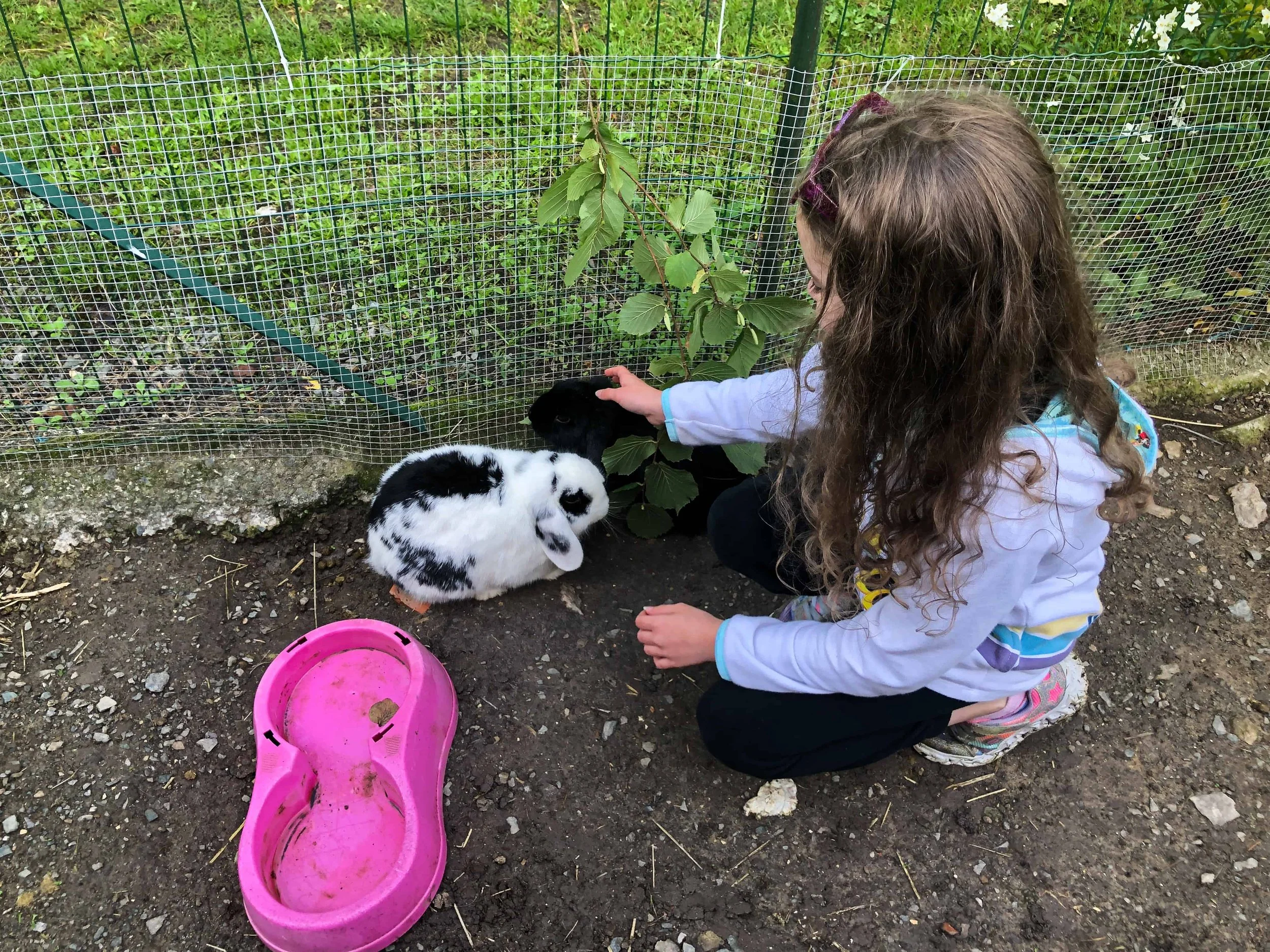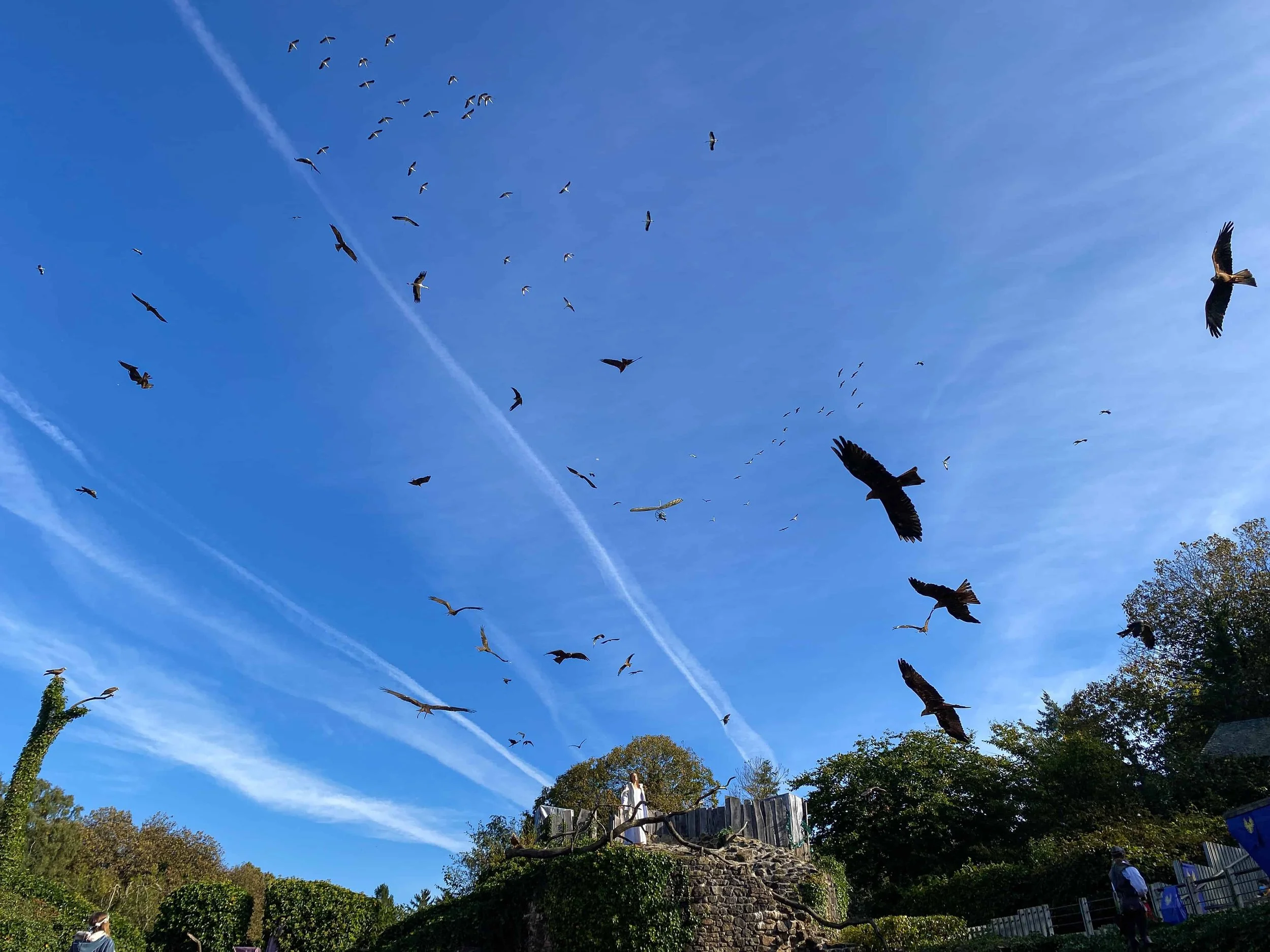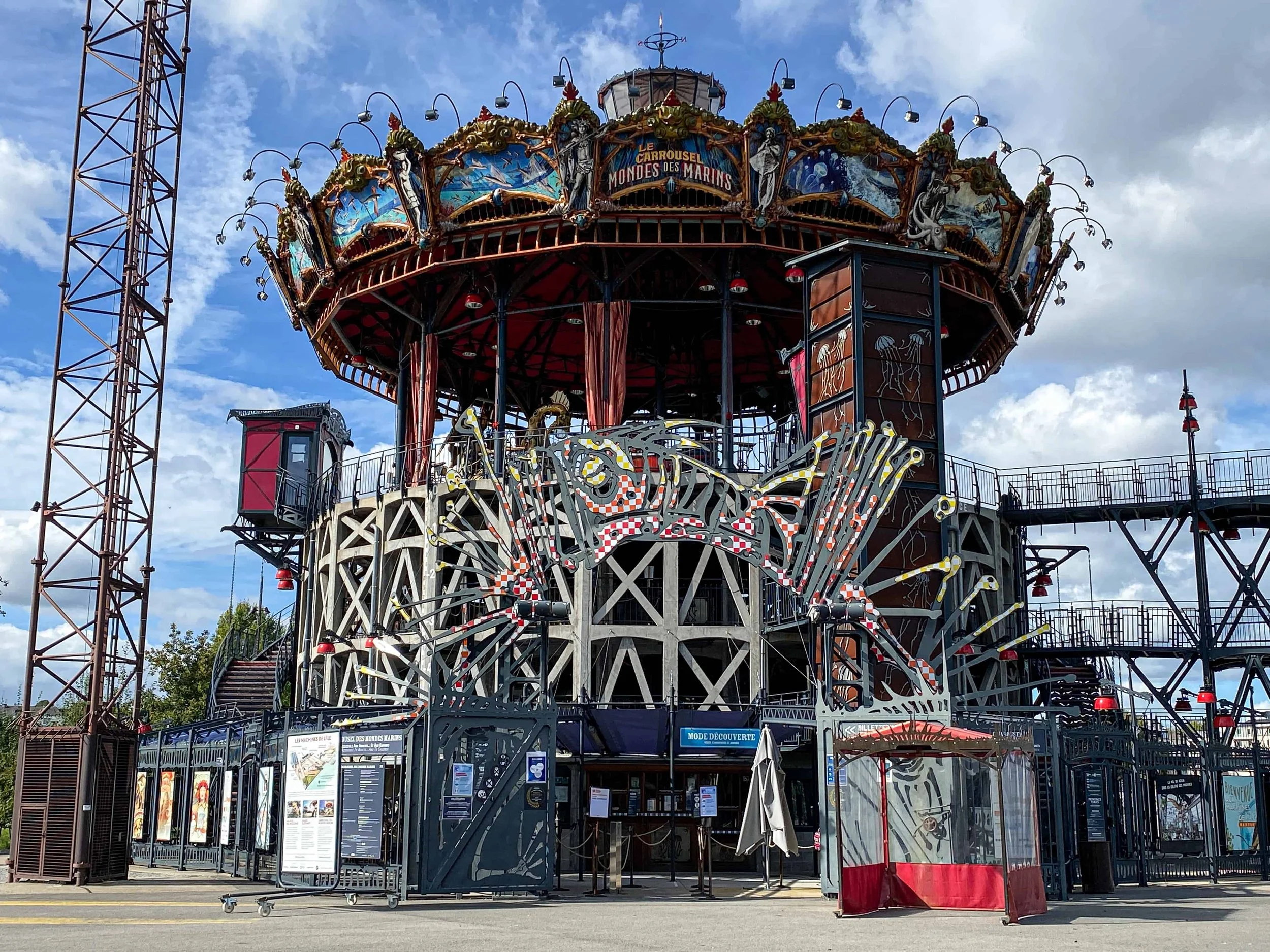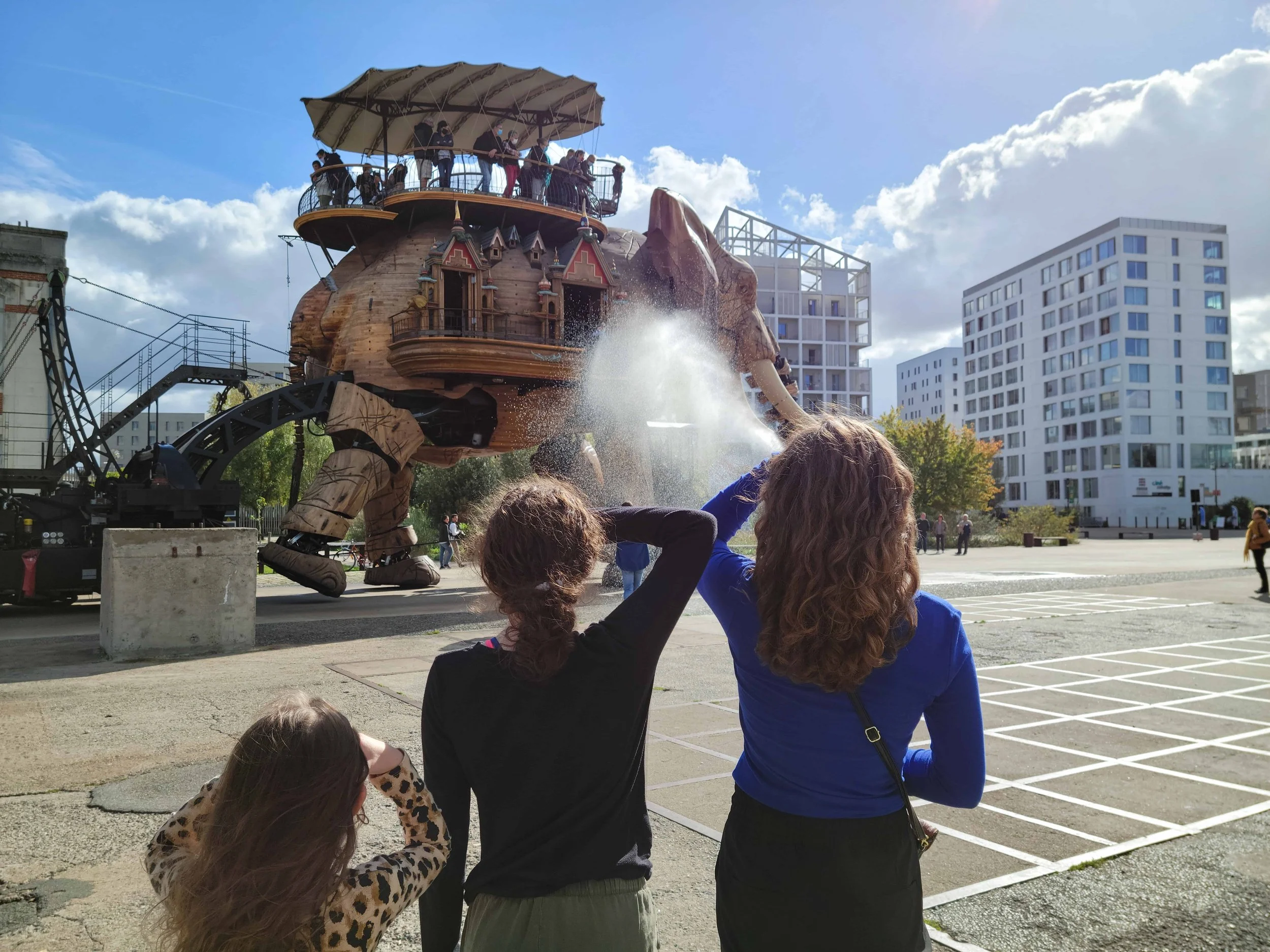15 Reasons to Visit Pays de la Loire, France with Kids
Best Places to Visit and Things to Do
“Blessed are the curious for they shall have adventures.”
Rachel & Sophie pose on a bridge in a medieval village in Puy du Fou
The Pays de la Loire region of France has something for everyone. History buffs, architecture enthusiasts, foodies, water adventurers, and those who love nature will all find enjoyment in this region. Located south of both the Brittany region and the Normandy region, it runs along the lower stretches of the Loire River (the longest river in France). The region provides access to countless sites and activities. Along with being home to beautiful coastlines and lush landscapes, this region is also a leading producer of dairy, beef, pork, and poultry. There are also several fishing ports so seafood is abundant here as well. The climate is oceanic, similar to that of the Pacific Northwest in the US.
Nantes is the capital of the region and is a great place to spend a few days. Other cities, such as Angers, Le Mans (home of the world-famous grand prix), and Saint-Nazaire have much to offer. Even many of the smaller towns are worth a visit. In this post, we’re providing some great places to visit and things to do if you’re visiting the region with school-aged children. You’re sure to find a number of things that will entertain your family and help you make unforgettable memories during your visit.
We’ve provided links throughout this post to other articles we’ve written on our personal experiences in Pays de la Loire. We’ve also included links to outside resources for places and activities that we haven’t experienced yet but that we have added to our bucket list. We hope you’ll find this information helpful when planning your own trip to the region.
15 Reasons to Visit Pays de la Loire, France with Kids:
Try a Family Farm Stay – Our Airbnb for several nights while in the region was a French Family Farm. While there, we enjoyed quiet days filled with sunshine, fresh air, and relaxation. Our host even put the girls in charge of a pair of bunnies for the duration of our stay. They had the joy of unlimited access to the bunnies while they fed, watered, and played with them. You can read more about our stay in our post called French Family Farm Stay. We definitely encourage you to consider adding these types of unique accommodations to your travel itinerary. A farm stay is such a great option for families because it provides opportunities to unplug, recharge, and bond with each other while participating in unique activities and animal interactions. This wasn’t our first farm stay. We stayed at a friend’s farm in the United States a few years back, and we even did a post called Family Fun on the Farm that details our experience there, along with giving 5 recommendations for farm stays throughout the US for a unique family vacation.
Click on photo to enlarge and see descriptions.
Puy du Fou Theme Park – This incredible theme park was one of our favorite experiences in our entire 3 month tour of France. There’s no better place than Puy du Fou to learn about the rich history of France, told through original and technically innovative shows, immersive attractions, recreated villages, and comedic entertainment. It is truly spellbinding! Their use of creative story-telling transported us to various events in history and we could easily grasp the story, despite the language barrier. We felt that the quality of the shows was unparalleled, even by the most popular theme parks in the world. You can read a more detailed account of our visit in our post called Puy du Fou, France. We very much want to return to this park in the future and also look forward to visiting their sister park in Spain and future expansions in other parts of the world. As with many of the parks mentioned in this post, this park is closed during the winter months so be sure to check their calendars before visiting.
Terra Botanica – Located in Angers, Terra Botanica is the world’s only theme park dedicated to plants. Over 275,000 species of plants are represented in climate controlled greenhouses and gardens. Boasting shows, attractions, rides, animations, and even a special night experience, Terra Botanica provides a family-friendly atmosphere. Kids of any age can learn about six centuries of plant life history and discover how plants impact our future. In addition to plant exploration, kids will also enjoy a great playground, a butterfly house, and hands-on workshops. A hot air balloon ride will give visitors a bird’s eye view of the park. There’s also a boat ride, a treetop ride in a nutshell, and even an encounter with a T-Rex! It’s a great way for your kids to learn while having fun.
Zoo de la Flèche – Located in Le Mans and boasting over 1,500 animals, representing 130 different species, this zoo is the oldest in France. Despite being around since 1946, it has continued to grow and evolve. Here you’ll find 18 hectares with more than just animals in their habitats, you’ll also enjoy immersive experiences, shows, a natural woodland, and beautifully landscaped gardens. Zoo de la Flèche is deeply committed to conservation and education and it is a great place for families to spend a day. (Please note that the zoo’s website is in French only so you may need some help from Google Translate.) You can even have an overnight experience at the Safari Lodge and Suite where you can choose to spend the night with a full view of lions, lemurs, grizzly bears, or several other species of animals.
Ocearium de Croisic – The seeds for Ocearium de Croisic were planted back in 1968 when Janine and Jean Auffret, wholesale sea-fish merchants, installed a small aquarium in their shop to give their customers something to look at while waiting. Over time, the concept grew and evolved into the space it is today with 56 aquariums and over 250,000 visitors a year! Visitors can see sharks from Australia, fish species from the Mediterranean, a selection of stingrays, and a colony of penguins. Committed to conservation, Ocearium de Croisic organizes several activities each year aimed at saving our oceans. In an effort to help save the penguins in South Africa, the aquarium works with the European Endangered Species Program (EEP), to collect data and optimize breeding of the African penguins.
Monkey Forest Adventure Park – Near La Baule, you’ll find a thrilling adventure park for all ages. Monkey Forest Adventure Park is located in a 6 hectare forest and offers a 100% secure ropes course with 16 different tracks. The park features games and experiences for visitors of all abilities. There are even treasure hunts and obstacle courses. While we did not get a chance to visit this particular park, we did visit a similar one while in the Normandy region of France and it was a wonderful opportunity for our girls to explore the outdoors, challenge their limits, and get some exercise. You can read about it in our Bayeux Adventure Park, France post.
Les Machines de L’île, Nantes – This gem in Nantes is well worth a day trip to spend several hours exploring. We thoroughly enjoyed La Galerie des Machines which is an interactive workshop where the engineering sketches of Leonardo da Vinci are brought to life in 3D machines that visitors actually get to control. Our girls (even our adult daughter) absolutely loved the workshop. Despite the language barrier, we were able to understand almost everything because the machinists were so patient and eager to make sure we enjoyed our experience.
Across the courtyard from the workshop, you’ll find the Carrousel des Mondes Marins, a carousel rising 25 meters high and 22 meters in diameter. The ride consists of three distinct levels for visitors to admire, interact with, and ride. If you time things well, you might even get to see Le Grand Eléphant make its way across the courtyard toward the Carousel. If you’d like, you can even purchase tickets to ride the enormous pachyderm. We were thrilled with our experience at this amazing museum workshop and you can read more about our time there in our dedicated post, Les Machines de L’île Nantes, France.
Château des Ducs de Bretagne, Nantes – Built in the late 15th century, this castle (known as the Castle of the Dukes in English) contains six centuries of history. It was originally built by François II, and the work was continued by his daughter, Anne of Brittany, who was twice Queen of France. François II, the last Duke of an independent Brittany, wanted to make the Château des Ducs de Bretagne both a military fortress, which could act as a defense against the King, and the principal residence of the court. The property has been listed as a historical monument since 1862. In 1915, before becoming a museum, it was sold by the government to the City of Nantes. During World War II, the occupying German forces built a bunker in the courtyard.
No admission is necessary to access the courtyard, rampart walk, and moat gardens. Admission for the museum and any temporary exhibits is very reasonably priced at about 9 Euros per adult, with visitors under the age of 18 getting free access. The museum also offers free admission on the first Sunday of every month, except in the months of July and August.
Nantes Cathedral – This Roman Catholic Gothic cathedral, which took over 457 years to complete, is known to locals as the Cathedral of St. Peter and St. Paul. Construction began in 1434 and took place in phases. The gothic facade was completed around 1508 and the building was finally inaugurated in 1891. In addition to its stunning 500m of stained glass and its two enormous towers that rise above the red rooftops of the city, the cathedral is also the final resting place of François II and Marguerite de Foix, parents of Anne of Brittany. Their tomb is a Renaissance masterpiece created by Michel Colmbe in 1507, under the orders of their daughter.
Unfortunately, Nantes Cathedral is currently closed for renovations after a damaging fire in 2020. (Please note that the website is only available in French so you may need some help with Google Translate.) The fire came just a little over a year after a massive fire at the iconic Notre-Dame Cathedral in Paris. Thankfully, about 100 firefighters managed to save the main structure and renovations are expected to be completed in early 2025. During the repairs, an exhibition in front of the cathedral shows the work in progress. Despite its current status, we felt the church really needed to be included in this list due to its historic significance to the Pays de la Loire region and its distinction as Nante’s largest landmark.
Fortified City of Guérande – Often referred to as the “Carcassonne of the West,” Guérande is a medieval city that is completely enclosed by ramparts. Located on a peninsula known as the Guérande peninsula, the town is bordered by the Atlantic Ocean to the west and the marshlands to the east. The Loire River flows to the south and the Vilaine River is found to the north. Behind the medieval stone walls, lies a town with rich Celtic art and history. The town is home to a number of historic churches and buildings and is worth some exploration. The real crown jewel of Guérande, however, is the salt marshes.
The Guérande Salt Marshes are a huge wetland zone between the Loire and Vilaine rivers. The salt has been harvested on the peninsula since the Iron Age with the first salt works going back to the 3rd century, shortly after the Roman conquest. This production of salt has been a source of wealth for Guérande for centuries. Originally, the town was protected by embankments which proved insufficient when the town was ransacked by the Spanish in 1343. This attack instigated the building of the ramparts that continue to protect the town.
Modern-day salt workers use essentially the same techniques as their ancient ancestors, obtaining 100% natural salt without the use of machines. The Guérande salt is particularly rich in magnesium and other trace elements. To learn more about how the salt is formed and how the circuit operates, you should visit Terre de Sel for a tour. We have put this on our list for a return trip to the area and think it would be a great opportunity for a homeschool field trip for our girls who are always looking to learn new and interesting things.
Spend the day exploring Le Mans – Although best known for its motorsports connections, specifically the famous 24-hour motorsport endurance race, the town of Le Mans is also steeped in history. A fortified Roman town built on a prehistoric settlement, Le Mans was awarded the label of Ville d'art et d'histoire (City of Art and History) by the Ministry of Culture in 2002.
Take some time to wander the cobbled streets of the historic quarter and be sure to visit Saint-Julien cathedral. The cathedral is a breathtaking architectural nod to both the Gothic and Romanesque eras. Pay homage to the town’s famous annual 24 hour race by visiting the Le Mans Museum. The museum displays 120 cars from previous races. In addition to learning about the race, the cars, and the teams, the museum features educational models and a workshop of engineers to provide a learning experience for all ages.
In the summertime, Le Mans lights up the night sky with La Nuit des Chimères. After dark, projected images appear on the city’s historic monuments, such as the Roman wall and the Saint-Julien Cathedral. It’s a sight to behold and entertains young and old alike.
Visit the locally loved seaside resort town of Le Pouliguen – While the resort town of Le Pouliguen tends to be more popular with locals, we found it to be a relaxing retreat for us to unwind, recharge, and explore the rugged cliffs, caves, and boulders of that rocky section of the coast. We loved staying at an Airbnb that appeared to be a well-loved, and well-supplied vacation home for the owners. The home we stayed in was just a few blocks from the rugged beach area that spans 7 km between Le Pouliguen and Le Croisic. It is considered the wild coast of the Côte Sauvage and offers a series of cliffs, caves, and granite coast for endless exploration. The famous GR34 footpath spans from Mont-Saint-Michel in Normandy (the Bay of Mont-Saint-Michel is in Brittany but the town itself is in Normandy) to Saint Nazaire in Pays de la Loire and runs right through this section of Le Pouliguen providing stunning views of the wild Atlantic coastline. Even though we visited in October when the weather was rainy and a bit windy, we put on our rain jackets and walked to the beach to explore all the nooks and crannies. We were mesmerized by the various views and loved watching the waves hitting the boulders to create spectacular sprays.
Have a beach day – With over 450 km of coastline, Pays de la Loire is home to some of the most beautiful beaches in France. Here, you’ll find the popular seaside resorts of La Baule, Saint-Jean-de-Monts, Pornichet, and many others. The coastline along La Baule is considered one of the most stunning beaches along the Côte d’Amour (the coast of love). It is also located near the border with Brittany where you can find some delicious crêperies along with bars, cafés, and restaurants located on the main street - the Avenue de Gaulle.
La Plage de Saint-Jean-de-Monts is a long golden sand beach that has become a favorite spot for swimmers. It is family-friendly thanks to its clear water, moderate waves, and beautiful setting. The resort town of Pornichet is a popular family resort and actually boasts three beaches, including Plage des Libraires (booksellers beach) and Bonne Source.
Plage de Sableux has a long coastline with fine sands and clear waters surrounded by vegetation. It provides an excellent opportunity for swimming and surfing. It is loved by locals but doesn’t get as crowded as some of the more well known beaches like La Baule.
Discover the Foods of the Region – Food and gastronomy in Pays de la Loire are strongly linked with the geography of this Western part of France. Tender meats and delicious dairy are produced at the local farms. The eastern part of the region also has an abundance of wild game available including wild boar and venison. Seafood is featured in the oysters from Port du Bec and the shellfish and mussels from Aiguillon. Freshwater salmon and pike are fished from the abundant rivers and streams. The region is also a thriving source of produce, particularly mushrooms, berries, asparagus, and new potatoes.
One of the most popular recipes of the region is beurre blanc sauce. The sauce is said to have originated in Nantes in the 1890’s when a chef forgot to add eggs to the bernaise sauce. It is a well-loved staple of the region made with local white wine and fresh whole butter. The rich sauce is the perfect pairing with fresh local fish like salmon and cod. Thanks to the numerous freshly mined salt marshes, you’ll never lack a deliciously seasoned meal.
While savory foods are available in abundance, the region also caters to those with a sweet tooth. The most famous treat, the petit beurre biscuit, originated in Nantes during the 19th century. You’ll even find the chocolate-covered version of the well-loved French butter cookie, the petit écolier, which is branded with the image of a schoolboy in milk chocolate.
In addition to the abundant selection of local foods, the Pays de la Loire region also has a stellar reputation for wine and liqueur. Owing its flavor to the local limestone upon which the grapes grow, Saumur wines have a delicate sparkle, reminiscent of Champagne. Each year, 15 million bottles of Saumur Brut and Crémant de Loire are exported around the world. The orange liqueur known as Cointreau is famous throughout the world. It was first developed in Angers in 1849. Clearly, there is an ample selection of culinary delicacies to be sampled in the Pays de la Loire region.
Explore a Troglodyte Cave Dwelling – The Pays de la Loire region is home to an extensive number of troglodyte caves, some of which date back several centuries. The word troglodyte refers to people who live primarily in cave dwellings. Due to the extensive mining of tufa limestone used to build homes and castles in the region, a vast network of caves was created within the landscape. Traditionally, these abandoned mining sites were claimed by less wealthy inhabitants who used the carved out structures to create homes. Entire villages were created that have lasted for centuries. Today, most of these troglodyte caves have been repurposed with some of them serving as wine storage and others as shops or bed and breakfasts that cater to tourists. (There’s even one that currently exists as a zoo!) Surprisingly, however, many of them are still inhabited by full time residents.
There are plenty of opportunities to experience these unusual cave dwellings while visiting the region. While we have not personally experienced the troglodyte caves, we have done a good bit of research on where we can have the best tour experiences the next time we visit the region. We’ve provided some information and links below so that you can learn more and add them to your list as well. Please note that some of these websites are in French only so you might need some help with translations (Google Translate can be very helpful).
Classified as a historical monument and located 10 km from Saumur you’ll find Château de Brézé which is a château under another château. This unique structure dates back to the year 1063. It was built in a vast vineyard and sits on an extensive network of tunnels. It has a rich history with royal ties including a visit by the young King Charles of France and his mother, Catherine de Medici, in 1563. It was occupied by German armed forces during WWII and, eventually, opened to the public in 1998. Visitors will also appreciate the dry moats which are considered the deepest in Europe. There are several ticket options and an audio tour is also available.
Saut aux Loups in Montsoreau is both a historical and a tourist site which includes a museum, a restaurant, and a unique mushroom house that is still in operation. Here, you can taste Galipettes, the local signature dish featuring a mushroom filled with your choice of rillettes, andouille sausage, salmon, snails, or goat cheese and baked in the oven. You can also learn all about the cultivation of various forms of mushrooms including button, oyster, and shiitake. You can even sample them during your tour, which is available in both French and English.
Biopark of Doué-la-Fountaine is located in Anjou, near Saumur. This, the only troglodyte zoo in the world, features tunnels carved out of the rock that will take you from one area of the park to another. The unique landscape of this zoo provides an unparalleled view, making it seem like there is no barrier between you and the animals. Here, you’ll find more than 1,300 animals in a beautiful natural setting which boasts the largest aviary in all of Europe! The natural caverns also provide plenty of shade, even on sunny days.
Instead of being carved in cliffside rocks, the Rochemenier Troglodyte dwellings have been carved out of the flat plain landscape. You’ll want to visit the Rochemenier Museum if you’re in the area. At this unique museum located in Anjou, families can explore 10,000 square meters of underground farms with over 1,000 years of history. You can choose to have a guide, but self-guided tours are also quite popular as maps are provided in 18 different languages and guide books are available in French, English, and German-Dutch. A family pass for 2 adults and 2 children (ages 6-14) is available for about 24 Euros. Children 5 and under are free.
The Pays de la Loire region has so much to offer visitors of all ages and interests. From the beaches, to the forests, outdoor enthusiasts will have abundant opportunities to enjoy the lush landscapes. From opulent historical buildings to cave dwellings, you can explore the way multiple cultures have made this region their own. Zoos, aquariums, tree top adventures, outdoor activities, and unique amusement parks all offer opportunities to learn, grow, and challenge yourself physically. We hope we’ve inspired you to add this beautiful region of France to your future travels. Have you been to the Pays de la Loire region? If so, we’d love to hear from you. Let us know if we captured your favorite things.













